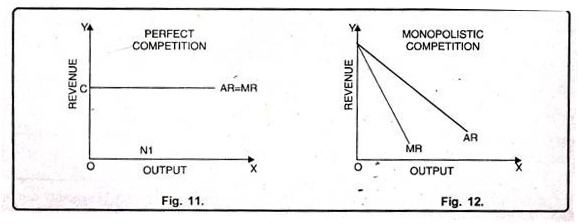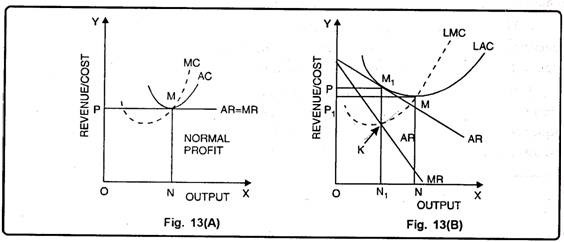This article will help you to learn about the difference between perfect competition and monopolistic competition.
Difference between Perfect Competition and Monopolistic Competition
Difference – 1. Nature of Firms:
Under perfect competition an industry consists of a large number of firms. Each firm in the industry has a very little share in the total output.
The firms have to accept the price determined by the industry. On the other hand, under monopolistic competition the number of firms is limited.
ADVERTISEMENTS:
The firms can influence the market price by their individual actions.
Difference – 2. Nature of Price and Output:
Under perfect competition price is equal to marginal cost as well as marginal revenue whereas under imperfect competition it is not so. Although, under monopolistic competition marginal cost and marginal revenue are equal yet not equalizing the price.
Difference – 3. Nature of Profits:
Under monopolistic competition firms get super normal profits only in the short period. But, in the long run the existence of super-normal profits disappears. It is so because in the long period price becomes equal to average cost of production. In case of perfect competition, the situation is slightly different.
Difference – 4. Nature of Product:
Under perfect competition, firms produce homogeneous products. The cross elasticity of demand among the goods is infinite. Under imperfect competition, all the firms produce differentiated products and the cross elasticity of demand among them is very small.
Difference – 5. Selling Costs:
ADVERTISEMENTS:
Another point of difference between the monopolistic and perfect competition is regarding the selling costs. Under perfect competition, homogeneous goods are produced and are sold at uniform prices. Thus, there arises no necessity of selling costs. On the other side under monopolistic competition, all the firms produce differentiated products, thus, each firm has to bear the huge expenses on selling costs.
Difference – 6. Slope of Demand Curves:
The demand curve of a firm under monopolistic competition slopes downward. It is due to the reason that each firm has to reduce the price, if it wishes to increase the sale (Fig 12). The situation under perfect competition is not so. Under perfect competition the firm can sell any amount of his output without lowering the price, thus, the curve remains parallel to horizontal axis (Fig. 11).
Difference – 7. Relation between AR and MR:
Under perfect competition, average revenue and marginal revenue are equal, so both these curves coincide with each other. Under monopolistic competition average revenue is more than marginal revenue because the firm has to lower the price to increase sales. Thus marginal revenue is less than average revenue i.e., AR > MR.
Difference – 8. More Price in Monopolistic Competition:
ADVERTISEMENTS:
Under monopolistic competition price is higher than price under perfect competition in long period because a perfect competition firm extends output up to the point where average cost is lowest i.e., there is optimum output in perfect competition.
However, in monopolistic competition firm stops the production before it has attained the optimum output. It has been shown by Fig. 13 (A) and 13 (B). In Fig. 13 A, perfect competition firm is in equilibrium at point ‘M’ where MC is equal to MR. At this point AR is also equal to LAC at its lowest point.
The equilibrium output is ON and equilibrium price is OP. In fig. 13 (B) a monopolistic competition firm is in equilibrium position at point ‘K’ where MC=MR. The equilibrium output is ON1 and price is OP. In the equilibrium position the firm is earning normal profit. If we compare the equilibrium price under both market situations, it is clear that price in monopolistic competition market is higher than that of the price in perfect competition market.
Difference – 9. More Output under Perfect Competition:
In the perfect competition market output is more than the monopolistic competition market output. In long period, under perfect competition MC = MR = AC = AR in equilibrium position as has been shown in Fig. 13 (A). Under monopolistic competition, in the equilibrium position MC = MR but AR is more than MC or MR.
That is the reason that in monopolistic competition output is lower than the output in perfect competition as is clear from Fig. 13 (A). In the Fig 13 (B). Monopolistic competition output is ON/ and perfect competition output is ON.
Difference – 10.
Perfect competition is an imaginary situation, whereas monopolistic competition is a reality.
Difference – 11.
ADVERTISEMENTS:
Under perfect competition, an inefficient firm cannot exist but under monopolistic competition both efficient and inefficient firms can exist because buyers have their irrational preferences for goods in the market.

